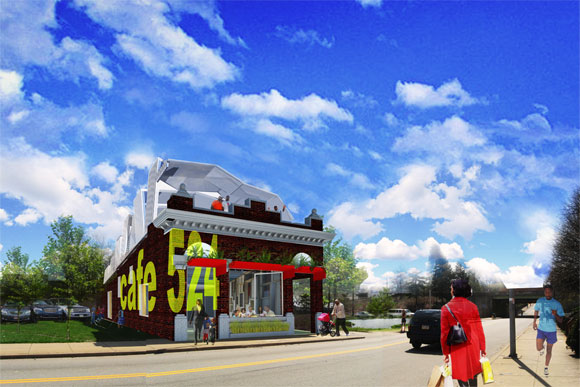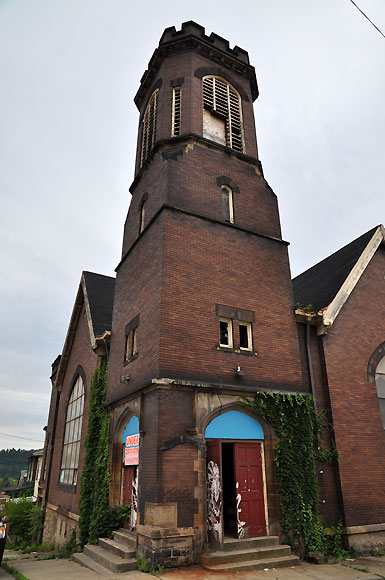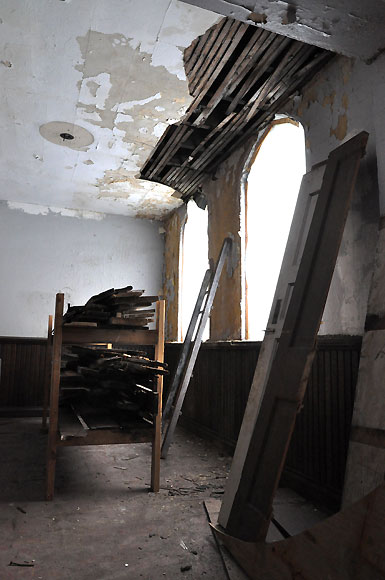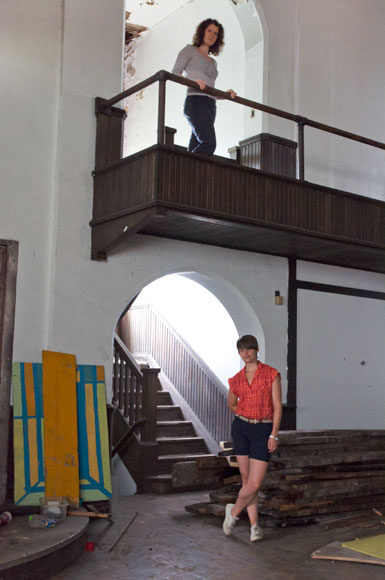
Category Archive: Easements
-
Garden Theatre Plans in Works
By Sam Spatter, FOR THE PITTSBURGH TRIBUNE-REVIEW
Thursday, June 17, 2010Five developers — three from out of town — are scheduled to present plans for redevelopment of the Garden Theatre block in the North Side to residents at a community meeting next month.
“This will give the developers an opportunity to explain their plans and for the residents to offer their comments,” said Mark T. Fatia, executive director, Northside Leadership Conference, which received the proposals this week.
The developers are considering a mix of residential and first-floor commercial, Fatla said.
The two local developers are Barron Commercial Real Estate of Pittsburgh and Aaron Stubna of Coraopolis.
The out-of-town developers are Resaca LLC of Bethesda, Md., Wells and Co., Spokane, Wash.; and Zukin Development Corp., of Philadelphia.
Fatla said developer Bill Barron has been active along Butler Street in Lawrenceville, and has started work along Federal Street on the North Side. Stubna is only interested in the Garden Theatre, which he would use for films and art projects.
Resaca, an apartment developer, is interested primarily in the Bradberry Building, a former department store.
Zukin, who recently purchased the drug store at Forbes and Murray in Squirrel Hill, is interested in historic preservation, a similar concept from Wells, which was attracted to Pittsburgh by Mike Edwards, president of the Pittsburgh Downtown Partnership, who formerly served in that capacity in Spokane.
“It will be up to the residents and the conference board to select a developer or developers, since some proposals do not include all of the properties within the block,” Fatla said. That could occur by the end of summer.
The block is bounded by Federal Street on the east, W. North on the south, Reddour Street on the west and Eloise Street, on the north. A previous failed development attempt by Jim Aiello Jr. involved only the Federal Street site, which was 30 percent of the total block project, Fatla said.
-
Study Offers 6 Options for Mellon Arena
By Jeremy Boren
PITTSBURGH TRIBUNE-REVIEW
Thursday, June 17, 2010Demolishing Mellon Arena would make way for a mix of new homes and high-end office space covering nine city blocks in the lower Hill District, according to a study released Wednesday.
The 107-page report provides the first detailed look at six scenarios, which include restoring the arena to its original 1961 design; mothballing it indefinitely; preserving its unique silver dome; and razing it to build 1,191 residential units and 608,000 square feet of offices.
Representatives of the city-county Sports & Exhibition Authority said last week that they favor demolishing the Igloo and allowing the Penguins to build a mixed-use development — a plan referred to as “Option 5” in the study, prepared by consultant Michael Baker Engineering of Moon.
The firm organized seven meetings and a tour of Mellon Arena for public input. The lengthy report is the result and is open to public comment and revision.
The SEA, which owns Mellon Arena, will consider comments on the report before the authority’s board of directors makes a decision on the arena’s fate, said Chris Cieslak, a consultant working with Oxford Development and the SEA.
“What we don’t want is what has happened in Portland, Oregon, where they have talked about it for nine years and the city of Portland has had to pay the holding costs on (Memorial) Coliseum,” Cieslak said. Groups have opposed razing the Pacific Northwest arena.
Penguins President David Morehouse said the team agrees with the report’s findings, which correspond to a market analysis performed by Penguins consultant AECOM.
He wants demolition of Mellon Arena to begin in a year. The team owns the rights to develop the site.
“The last thing we want to do is put an impediment in front of a developer and say: ‘We want you to put this development in but, by the way, you have to put it underneath this dome,'” Morehouse said. “The people proposing that have no developers and no money for that.”
Those trying to save the arena from destruction are surprised by the study’s release. Architect Rob Pfaffman, founder of the Reuse the Igloo group, said he wasn’t aware the full report was available until told by a reporter.
Pfaffman’s vision is to build a boutique hotel inside the arena with retail and open-air park space.
“They have gone on the record, at least with us, that they prefer Option 5,” Pfaffman said. “We don’t think the process was properly followed.”
Pfaffman’s preservation group hired its own consultant to examine alternatives to tearing down the 49-year-old arena — the National Hockey League’s oldest venue. Mellon Arena will be replaced by the $321 million Consol Energy Center when it opens in August across Centre Avenue.
Pfaffman said if the SEA was sincere about finding alternatives to demolishing Mellon Arena, the authority would conduct a more detailed study and perform an engineering analysis of the building.
Neither has occurred.
The study said that in addition to making room for office space and homes, demolishing the arena would allow three north-south streets to be built. The streets would connect Bedford and Centre avenues — roads that planners eliminated when building the arena.
Razing the arena also would provide space for 208,750 square feet of retail development; a 150-room hotel; 2,145 parking spaces; and 57,560 square feet of “public open space located along pedestrian corridors,” the study said.

-
Homewood’s Cafe 524 Blends Community With Sustainability and Coffee
Pop City Media
Wednesday, June 16, 2010
A collaboration of community leaders is aspiring to create a bright, sustainable place for business development and coffee in a former Homewood post office.
More than just a coffee shop, Café 524 hopes to spur the rebirth of the Homewood business district and serve as a catalyst for sustainability and community activities. The cafe will be located at 524 N. Homewood Ave.
The project has been a work in progress for the past year, bringing together diverse partners to make it happen: the National Black Masters of Business Administration Association (NBMBAA), URA, Urban Design Building Studio (UDBS), The Homewood Children’s Village and PJ Dick Incorporated.
“It’s very much a collaborative effort that grew organically out of dialogue and community meetings,” says John Folan, director of Carnegie Mellon’s UDBS, a studio of interdisciplinary architecture students who are working on the design. UDBS’s mission is to develop climate appropriate building technologies for neighborhoods in Allegheny County.
“It’s a remarkable opportunity for the students, enabling them to work with the community and a real client, giving them a very real sense of working on a project with real partners and multiple entities,” Folan adds.
Café 524 will be net-zero, powered by a geothermal energy system, and serve as a community meeting place and arts and culture destination . The NBMBAA hopes to buy the building from the URA and run a business incubator and real estate business on the second floor to stimulate local business development. The first floor will be leased as a for-profit coffee shop, drawing patrons from the nearby bus stop and neighborhoods.
The project is an extension of another ongoing neighborhood project, the Homewood Children’s Village.
Construction will begin this August and be completed by the spring of 2011. The URA has offered the partners $100,000 toward the predevelopment costs. The collaborators hope to attract the interest of foundations and corporate sponsors we well.
Writer: Debra Diamond Smit
Source: John Folan, UDBS -
Under Deconstruction: Transformazium
Pop City Media
John Farley Wednesday, June 16, 2010

Ruthie Stringer can’t relate to the image of Braddock portrayed in the media. “I think life is more complicated than that,” she says as she sits next to a massive pile of wooden joints in what was once The United Brethren Church in North Braddock. Following a fire that damaged part of the building in 2005, the property sat vacant until Ruthie and her friends purchased it in 2008.
In the Greater Pittsburgh area, over 30% of real estate is vacant or underutilized. Instead of viewing abandoned properties as symbols of blight and despair, Ruthie is taking part in a rapidly growing movement called deconstruction, a sustainable alternative to demolition, which sees opportunity and hope in these properties.
Deconstruction is the selective dismantling of a building for the purpose of reusing the materials to build new structures, and it is this process which Ruthie, along with formerly Brooklyn based artists Leslie Stern, Dana Bishop-Root, and Caledonia Curry (better known as Swoon), are using to turn their building into a community arts center called the Transformazium.
After the Pittsburgh space where Swoon and Leslie were planning an art show two years ago fell through, they were invited to move the show to Lauri Mancuso’s Dorothy 6 space in Braddock, which happened to be located on the first floor of Braddock Mayor John Fetterman’s house. “John showed Swoon the Brethren Church, and she fell in love with it,” explains Leslie.
Swoon, who was busy working on other projects around the world, asked her friends to move to Braddock in order to manage the property. They were able to purchase the building through the Allegheny Vacant Property Act, a form of eminent domain that allows the county to take abandoned properties and clear back taxes, in this case over $500,000, so that new owners can purchase the properties at a reasonable rate.
Shortly after purchasing the building, a friend suggested they attend a conference on deconstruction in Buffalo, NY, co-sponsored by Buffalo Reuse and The Building Materials Reuse Association, a non-profit that serves as a representative for the deconstruction industry, informing people about deconstruction and its benefits.
The Many Benefits
“We spent nine weeks learning about deconstruction, and what it would take to do it, ” says Dana. Instead of demolishing the damaged parts of the Transformazium, they dismantled the reusable materials, which they are using to rebuild other damaged areas of the building. As the Transformazium crew learned, the benefits of deconstruction over demolition are huge. The value of reusable salvaged materials directly offsets high labor costs the donation to Pittsburgh’s Construction Junction in Point Breeze, results in a tax benefit for the building owner. In addition, deconstruction offers major environmental benefits.“All reuse is a form of recycling, but not all recycling is reuse,” says Brian Swearingen, the head of Construction Junction’s deconstruction crew. “In deconstruction and reuse, we’re taking that same material, but using it for the same purpose, or slightly altering it for another purpose. When you do that, you’re saving energy, because you have less transportation costs, less energy costs, and no remanufacturing costs, which are high. A good example is a metal table. If you recycle that at a landfill, you have to put it on a truck, probably put it on a train, possibly put it on a ship, and send it maybe halfway around the world to make what is oftentimes a similar product.”
Construction Junction was set up eight years ago by the Pennsylvania Resources Council to spearhead a movement in Pittsburgh away from disposing waste in landfills without exploring its other purposes. They operate a store, which accepts donations of reusable materials from individuals and businesses renovating or demolishing buildings, and sells those materials at a low cost so they can be repurposed.
In addition to the economic benefits to builders and property owners, deconstruction and reuse provide large incentives for communities. “When you buy materials from Construction Junction, you’re helping provide a cost saving to people who are trying to run their small businesses. You are also helping us employ people to recover materials, which puts money back into the local economy,” Brian explains.
The possibilities of job creation through the deconstruction industry in Allegheny County are exciting. “When we’re asked to do an assessment of deconstruction vs. demolition from a workforce development standpoint, there are times when we could create 20 times more jobs deconstructing buildings than if we demolished them,” notes David Bennink, who will be hosting informational workshops about deconstruction in Braddock on June 17 and 18. David is a BMRA board member, Deconstruction Builder of the Year Award winner, and founder of ReUse Consulting, a 48-person company that performs deconstruction across the country for individuals and businesses, and trains people wanting to start their own deconstruction companies.
Let Me Count the Ways
“The jobs are created in four ways. There’s deconstruction and salvage at the jobsite, there’s processing and transportation, there’s retailing and warehouse like Construction Junction, and finally there’s what we call value added jobs, where we take materials and we add value to them in some way, such as reclaiming wood flooring or making old light fixtures more energy efficient,” says David.If deconstruction sounds like a dream industry, especially for revitalizing cities like Pittsburgh, why isn’t it a more common practice? Why have so few people even heard of it for that matter?
The answer to that question is multifarious, but for David the main problem is a lack of information. Oftentimes, contractors don’t tell property owners about deconstruction, because they fear it will put them behind schedule and cut into their part of the contract. “There are tons of people out there that say to us they didn’t know deconstruction was an option. They just knocked down their building, and they would have chosen deconstruction if they’d known,” he says.
Many people fear that deconstruction is too expensive or time consuming, but deconstruction is frequently faster and cheaper than demolition, and 95% of David’s clients over the past 17 years say they would still prefer deconstruction to demolition.
David and Brian both agree that legislation related to landfills is an obstacle. David is quick to point out that in some parts of the country, dumping fees at landfills are very inexpensive, rendering deconstruction unprofitable in comparison. “We’re always trying to point out that there are hidden costs when you do things too cheaply. An example of that would be if you took a bunch of computer monitors and threw them in the landfill, then naturally you have a hazardous waste problem. And this is a legislative issue, because if you’re doing things too cheaply, you’re passing on hidden costs to the future. That’s not really fair competition,” says Brian.
Despite the roadblocks, people involved with deconstruction in Pittsburgh appear very optimistic about the future. Legislation is evolving. For instance, California and Massachusetts have recently passed bills designed to discourage landfill use for materials that could be repurposed, which could encourage Pennsylvania to adopt similar laws. The Community Regeneration, Sustainability, and Innovation Act, a bill that provides economic support for deconstruction practices, is under consideration in Congress.
“We feel like we’re really onto something here. We’re reaching out to everyone and saying that we believe someday soon, deconstruction will be the main choice for building removal,” says David.
Although a lot of hard work still needs to be done deconstructing and rebuilding the Transformazium, the future seems bright. Swoon lives in Brooklyn, but is currently building an adobe dome in the lot across the street from the Transformazium, which will function as a community greeting space. Leslie, Dana, and Ruthie have completed two large projects that involved the community’s participation. It’s clear that the Transformazium is becoming more than a community arts center, but just what that will be remains uncertain, even to the Transformazium. “We are going to let it evolve more organically, and with input from our neighbors as well. We are definitely working towards a community garden in the lot, though”, says Leslie.
“One of the most exciting shift of perspectives has been realizing that the 15104 area is loaded with resources, and that it’s not simply blighted or abandoned. It’s full of people with a ton of skills and interests, there are several businesses that try very hard and care about the area and people, and there are lots of organizations and spaces.
“But not everyone knows or sees this. Deconstruction has allowed us this shift in terms of looking at all the abandoned buildings and seeing them as having tremendous potential value, instead of just being problems,” Leslie adds.
-
Construction to Begin on Connelley Center Project Next Fall
Wednesday, June 16, 2010
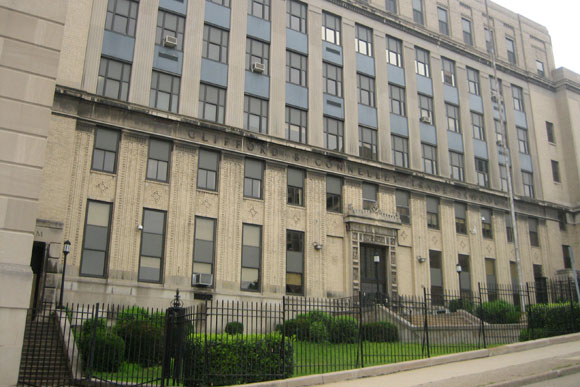
The former Clifford B. Connelley Vocational School will be converted into a green center for sustainable education.
State Senator Jim Ferlo and the board of Pittsburgh Green Innovators hosted tours of the former Clifford B. Connelley Vocational School last Thursday in the Hill District, in order to explain the progress that has taken place in their project to turn the former high school into a green center for sustainable education. The Connelley Project will be a major force in Pittsburgh’s movement towards green workforce development.
The Connelley project is organized by a partnership between Pittsburgh Green Innovators, and the developer Pittsburgh Gateways Incorporated, who are currently leasing the building from the school district. The school district had to shut it down in 2004 due to funding issues.
“The building purchase will be finalized in August, once the school board has finished moving all of its equipment out,” explains Deno de Ciantis, director of the Penn State Center, which plans to be an anchor program in the building.
After the purchase is made, the project will enter phase one of building construction. Both PGI and Green Innovators expect it should be completed by Fall of 2011. They intend to develop approximately 190,000 square feet of the facility’s 230,000 square feet.
“Capital fundraising efforts are on track. Upgrades to the building will include deep energy retrofits, the purchase of energy production equipment, and costs associated with LEED certification,” says Senator Ferlo.
Although a wide number of organizations have expressed interest in securing space at the building, de Ciantis says that leasing on spaces will not begin until after the purchase has been made. What de Ciantis and Ferlo are certain about, however, is that using the Connelley building to educate and train students and adults with the skills they need to excel in green job fields is critical to the growth of the green economy in Pittsburgh.
Writer: John Farley
Sources: Deno de Ciantis, Director of the Penn Center
Senator Jim FerloPhotograph Copyright John Farley
-
Former School to Become Green Center
Friday, June 11, 2010By Diana Nelson Jones, Pittsburgh Post-Gazette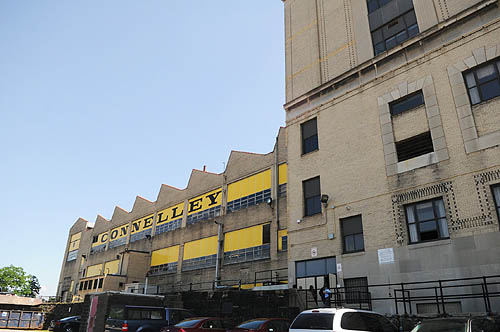
The old Connelly Technical Institute is planned to be used as a business incubator.
The 80-year-old former Connelley Technical Institute in the Hill District is slated to become a green technology demonstration showcase under the ownership of Pittsburgh Green Innovators Inc.
PGI has a sales agreement with Pittsburgh Public Schools and expects to close this summer and begin retooling the former vocational school by fall, said Deno DeCiantis, a PGI board member and director of the Penn State Center, an outreach service for Penn State University in Pittsburgh.

Now vacant, the fifth floor of the "Academic Tower" at the old Connelly Technical Institute contained a full-size commercial kitchen for its culinary students.
The Bedford Avenue school was closed in 2004. It has 220,000 square feet of space. When retrofitted, it will be loaded with green technology to demonstrate function and to absorb the building’s costs.
The prospective new owners envision the site as an incubator of green industry, a job training center for green-industry jobs and a technical support center for work force development.
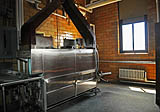
Now used as storage space, the fifth floor of the "Academic Tower" at the old Connelly Technical Institute previously served as a full-size commercial kitchen for its culinary students.
“There are so many jobs that will be created under the broad theme of energy independence,” said state Sen. Jim Ferlo, D-Highland Park, a PGI board member.
PGI is a collaboration of representatives from universities, labor unions, the Green Building Alliance, Hill House and a dozen other entities, plus Mr. Ferlo, state Rep. Jake Wheatley, D-Hill District, and U.S. Rep. Mike Doyle, D-Forest Hills.
Board members led two public tours of the building Thursday, from the spacious top floor with a view of the North Side to the darkened corridors lined with lockers to the ground floor of classrooms that are sky-lit by a sawtooth roof.
State grants of $4 million will enable the organization to create a geothermal pumping system that is expected to provide the building with 65 percent of the energy it will need, said Bill Miller of Pittsburgh Gateways, a nonprofit developer. The extension’s sawtooth roof — each panel of which slants toward the south — “is oriented perfectly for solar panels,” said Mr. DeCiantis.
“There’s nothing we’re doing that isn’t green” Mr. Miller said. Besides the geothermal system, he said, “the rest of our energy will come from solar, wind and microturbines fueled by different energy sources. We will do high-performance glazing, have a green roof, rain gardens and bioswales.”
Mr. DeCiantis said the first phase of retrofitting the building will be under way by fall.
The sales price will be about $200,000, Mr. Ferlo said, because PGI will take over the costs and burdens of remediation and rehabilitation that normally would be required of the seller.
The organization has raised $17 million from public and private donations toward an estimated $16.5 million for first-phase renovations, Mr. Miller said. The entire project will cost about $40 million, he said.
Two years ago, the initiative began establishing an alliance of unlikely collaborators: the Sierra Club, smart-growth advocates, labor leaders and academics.
Anchor tenants will be Penn State and the International Union of Operating Engineers Local 95.
When the project was in the early stage, founding board member Bernie Lynch said the organization’s goal “is to bring all these sectors together to make this an economic hotbed.”
-
Easement Conference and Members Tour Set for Harmony, PA August 28th
May 13, 2010
PHLF NewsLandmarks is inviting historic preservation organizations working within western Pennsylvania to Harmony, PA on Saturday, August 28th at 3:00 p.m. for a program on how Landmarks’ preservation easements program can protect historic and architecturally significant buildings in communities throughout western Pennsylvania.
The one-hour program will take place in Harmony’s Great Hall at the conclusion of a Landmarks-sponsored tour of the historic community. Harmony was the first home of the communal Harmony Society of German Lutheran Separatists, which founded Harmony in 1804 and organized formally as a Christian communal society in early 1805. In 1974, Harmony was designated as western Pennsylvania’s first National Historic Landmark district. Last year, the preservation group, Historic Harmony Inc., donated preservation easements to Landmarks on eight historic properties.
The cost of the tour is $48 for members, $65 for non-members and includes bus transportation to and from Harmony, lunch, tours, and special access opportunities. The bus departs from Station Square at 11 a.m. and returns at 5 p.m. There is no charge to attend the easement program.
More information on the tour and program can be obtained by contacting Jack Miller at jack@phlf.org or 412-471-5808, ext. 538.
-
Greene County Conservation Easement to Protect Farm
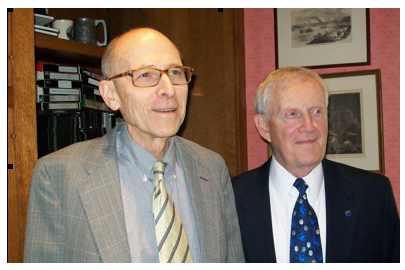 By Jack Miller
By Jack Miller
PHLF News
August 4, 2009Charles Evans Hunnell has donated a preservation and conservation easement to Landmarks that will protect his 136-acre farm located just west of Waynesburg, PA.
The easement will not only help to preserve the farm-related buildings on the century-old farm but also protect its land from commercial development.
Mr. Hunnell also made a gift to endow the monitoring of the easement in perpetuity.
This is the second Greene County farm protected by Landmarks and brings to 10 the number of properties on which Landmarks has obtained a historic preservation and conservation easement in the past four months.

